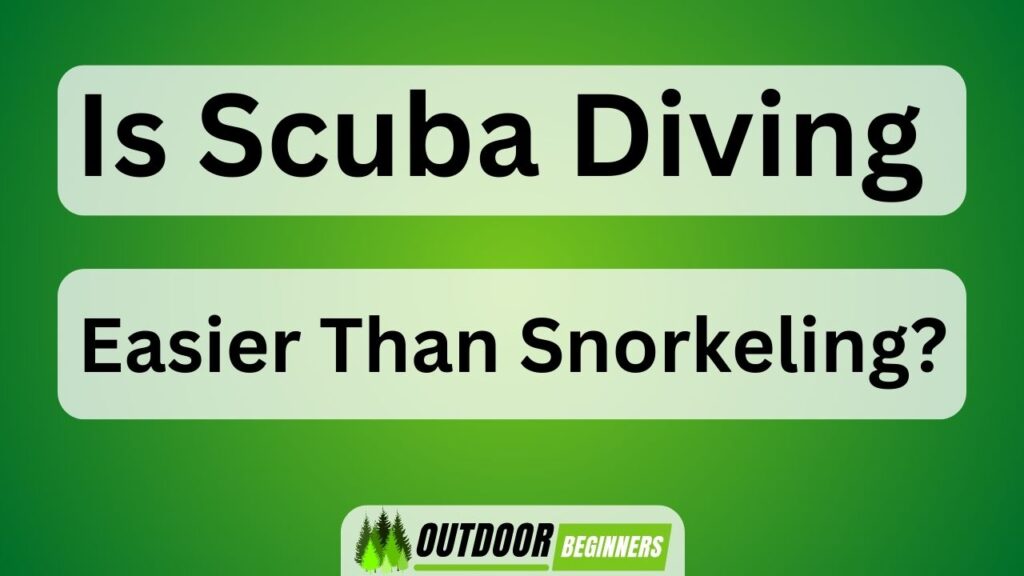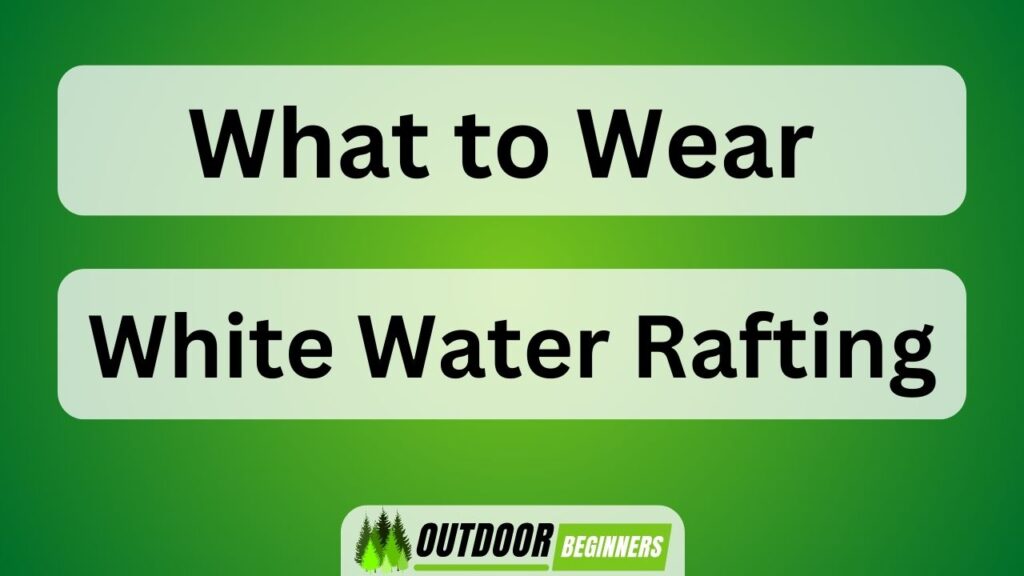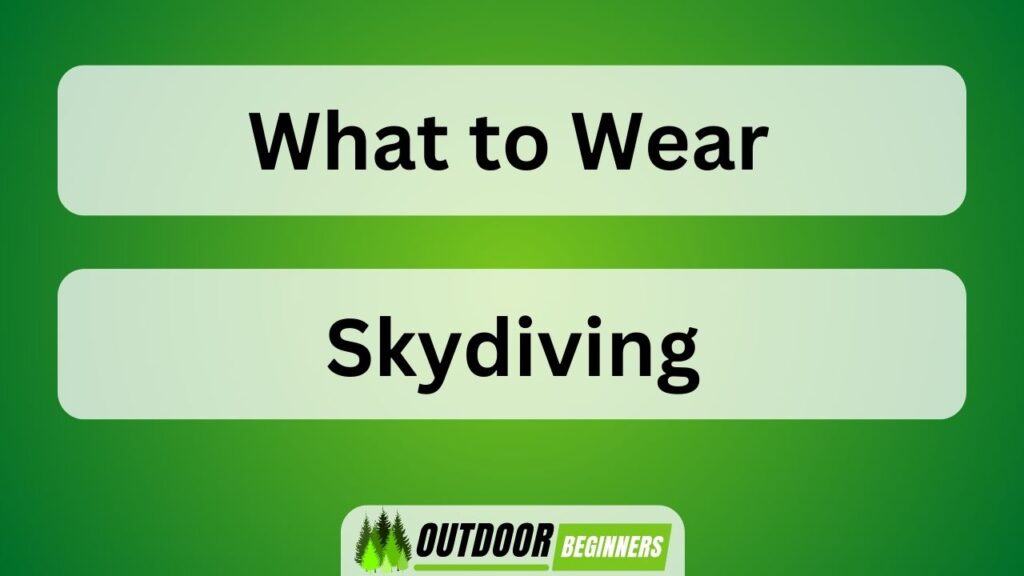Have you ever wondered if scuba diving is easier than snorkeling? Well, let us share our expertise and experiences with you.
Imagine this scenario: you’re floating on the surface of crystal clear waters, observing the vibrant marine life below. Suddenly, you spot a magnificent sea turtle gliding gracefully through the depths.
As avid scuba divers ourselves, we can confidently say that scuba diving offers a more immersive and exhilarating experience compared to snorkeling.
Join us as we explore the safety considerations, equipment differences, and skill requirements that make scuba diving an adventure like no other.
Key Takeaways Is Scuba Diving Easier Than Snorkeling
- Scuba diving requires more equipment and training compared to snorkeling.
- Scuba diving allows for deeper exploration and extended dive time.
- Proper breathing techniques are essential for both scuba diving and snorkeling.
- Safety precautions, such as understanding emergency procedures and carrying necessary equipment, are important in both activities.
Safety Considerations
When scuba diving, it’s important to take safety considerations into account. As experienced divers, we are well aware of the potential underwater hazards that could arise during a dive. These hazards include strong currents, marine life encounters, and limited visibility. To ensure our safety, we always adhere to strict emergency procedures.
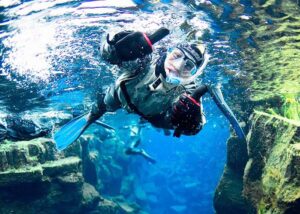
In case of an emergency, we are trained to remain calm and signal for assistance using specific hand signals or audible devices like whistles or bang sticks. We also carry essential safety equipment such as dive knives, surface markers, and signaling devices to communicate with other divers or boats above the water’s surface.
Understanding these underwater hazards and being prepared with proper emergency procedures is crucial in maintaining a safe diving experience for everyone involved.
Now let’s transition into discussing the equipment differences between scuba diving and snorkeling…
Equipment Differences
When comparing scuba gear to snorkel gear, there are several key differences to consider.
First and foremost is the breathing apparatus. With scuba diving, we utilize a regulator that allows us to breathe underwater by delivering air from a tank.
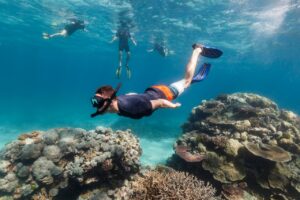
On the other hand, snorkeling involves using a simple tube or snorkel that allows us to breathe while floating face down on the surface of the water.
These contrasting breathing techniques greatly impact our experience and capabilities while exploring beneath the waves.
Scuba Vs. Snorkel Gear
If you’re looking for convenience, scuba gear is more complex than snorkel gear. Scuba masks are designed to withstand the pressure at greater depths and provide a clear vision underwater. They have a built-in equalizing mechanism that allows divers to equalize the pressure inside the mask as they descend deeper.
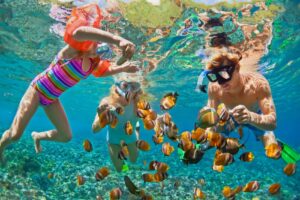
Benefits of using scuba gear include:
- Extended dive time: With scuba gear, divers can stay underwater for longer periods, allowing them to explore more and experience marine life up close.
- Greater freedom of movement: Unlike snorkeling where you stay on the surface, scuba diving allows you to move freely in three dimensions – up, down, and sideways.
Breathing Techniques Compared
To improve your diving experience, focus on mastering different breathing techniques. Proper breathing is crucial for scuba divers as it helps conserve air, reduces the risk of lung overexpansion injuries, and enhances relaxation underwater. By practicing specific breathing exercises and relaxation techniques, divers can optimize their air consumption and increase their bottom time.
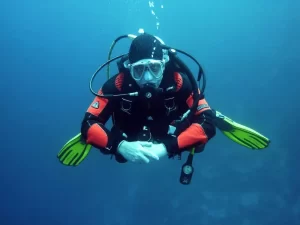
One effective technique is called “slow deep breathing.” This involves inhaling slowly through the nose, filling the lungs completely, and exhaling slowly through pursed lips. Another useful exercise is “diaphragmatic breathing,” which involves using the diaphragm to breathe deeply instead of shallowly using only the chest muscles.
In order to illustrate these techniques further, let’s take a look at the following table:
| Breathing Technique | Steps | Benefits |
|---|---|---|
| Slow Deep Breathing | Inhale slowly through nose | Conserves air |
| Fill lungs completely | Reduces risk of lung overexpansion injuries | |
| Exhale slowly through pursed lips | Enhances relaxation underwater | |
| Diaphragmatic Breathing | Place hand on belly | Increases oxygen uptake |
| Inhale deeply into belly | Promotes better buoyancy control |
Breathing Techniques
When it comes to snorkeling versus scuba diving, there are several key differences that need to be considered.
Firstly, snorkeling is a surface activity where the individual breathes through a snorkel tube while floating face down on the water’s surface.
On the other hand, scuba diving involves wearing a self-contained underwater breathing apparatus that allows for deeper exploration and extended periods underwater.
Understanding and practicing proper breathing techniques is crucial in both activities as it ensures efficient gas exchange and maximizes our time spent underwater.
Snorkeling Vs Scuba: Differences
You may be wondering what the differences are between snorkeling and scuba diving. Well, let us shed some light on this matter.
First and foremost, both activities allow you to explore the underwater world, but they differ in terms of equipment and depth limitations.
Here are some key differences:
- Equipment: Snorkeling requires minimal gear such as a mask, snorkel, and fins. On the other hand, scuba diving involves wearing a wetsuit or drysuit, a buoyancy control device (BCD), regulators, tanks, and weight belts.
- Depth Limitations: Snorkeling usually takes place near the surface of the water where you can see marine life from above. Scuba diving allows you to descend to greater depths for a more immersive experience.
When it comes to safety precautions, both activities require certain measures to ensure your well-being underwater. However, scuba diving requires additional training and certification due to its higher level of physical exertion and potential risks associated with breathing compressed air at depth.
Importance of Proper Breathing
Now that we have discussed the differences between snorkeling and scuba diving, let’s delve into the importance of proper breathing techniques when engaging in these activities.
Breathing is a fundamental aspect of any water-based activity, as it affects our buoyancy, relaxation, and overall comfort underwater.
Breathing exercises play a crucial role in enhancing our diving experience. By practicing deep inhalation and slow exhalation techniques, divers can increase their lung capacity and maintain a steady rhythm while submerged. This helps to conserve energy and reduce the risk of panic or anxiety underwater.
Relaxation techniques further complement proper breathing by calming the mind and body. Techniques such as visualization, meditation, and progressive muscle relaxation can help alleviate tension and promote a sense of tranquility before entering the water.
Skill Requirements
Contractions make scuba diving easier than snorkeling due to the reduced effort required. When it comes to scuba diving, skill level and physical fitness play crucial roles in ensuring a safe and enjoyable experience underwater. Here’s why:
- Skill level:
- Scuba diving demands more technical knowledge and training compared to snorkeling.
- Mastering skills like buoyancy control, equalization, and navigation is essential for a successful dive.
- Physical fitness:
- Scuba diving requires a moderate level of physical fitness.
- Stamina, flexibility, and strength are necessary to handle the equipment and navigate through currents.
Having the right skills and physical condition allows divers to explore deeper depths with ease. It enables them to stay underwater for longer periods, providing ample time to admire marine life and discover hidden treasures beneath the surface.
Transitioning into the next section about ‘training and certification,’ let’s delve into how one can obtain the necessary qualifications for scuba diving.
Training and Certification
Obtaining the necessary qualifications for scuba diving involves completing training courses and obtaining certification. The training methods vary depending on the agency or organization providing the certification, but they all aim to ensure that divers have the knowledge and skills required to dive safely. The certification process typically consists of a combination of classroom sessions, pool or confined water dives, and open water dives. These courses cover topics such as dive theory, equipment usage and maintenance, safety procedures, and emergency response techniques.
To give you an idea of what scuba diving training entails, here is a table outlining a typical certification process:
| Training Method | Description |
|---|---|
| Classroom Sessions | In-depth theoretical instruction on dive physics, physiology, decompression theory, and dive planning |
| Confined Water Dives | Skill practice in a controlled environment (e.g., swimming pool) to develop foundational scuba skills |
| Open Water Dives | Application of learned skills in real-world diving conditions under the supervision of an instructor |
With these comprehensive training methods and rigorous certification process in place, divers are equipped with the necessary knowledge and skills to explore the wonders beneath the surface.
Now that we understand how important it is to obtain proper scuba diving qualifications through training and certification, let’s delve into another crucial aspect: depth limitations.
Depth Limitations
To fully enjoy the underwater experience, it’s important to be aware of the depth limitations and understand how they can affect your dive. As scuba divers, we must have a solid understanding of our depth perception and its implications in terms of water pressure.
Here are some key points to consider:
- Depth Perception:
Underwater, our ability to accurately judge distances is compromised due to the bending of light caused by water. This can lead to misjudging objects’ positions or sizes, which may pose risks during ascent. - Water Pressure:
As we descend deeper, water pressure increases significantly. This can cause discomfort or even injury if not managed properly through controlled descents and ascents.
By acknowledging these factors and being mindful of our depth limitations, we can ensure a safer and more enjoyable diving experience.
Now that we understand the importance of depth control, let’s explore another crucial aspect of scuba diving: underwater navigation.
Underwater Navigation
Navigating underwater can be challenging due to limited visibility and the potential for disorientation. As experienced divers, we understand the importance of mastering underwater navigation techniques to ensure a safe and enjoyable dive. One crucial aspect is managing underwater visibility, which can vary depending on factors such as water clarity and depth. To emphasize this point further, let’s take a look at the following table:
| Water Clarity | Depth Range (ft) | Visibility |
|---|---|---|
| Clear | 0-30 | Excellent |
| Murky | 30-60 | Poor |
| Dark | >60 | Limited |
By understanding these ranges, we can plan our dives accordingly, taking into account visibility conditions for optimal marine life exploration. This knowledge helps us navigate through unfamiliar environments with confidence and ensures that we make the most of every dive. Speaking of marine life encounters…
Transition: With our navigation skills honed, we are better equipped to explore and appreciate the wonders of marine wildlife encountered during our dives.
Wildlife Encounters
Transitioning from underwater navigation to wildlife encounters, we’re able to witness the captivating beauty of marine creatures during our dives. Exploring the vibrant underwater world opens up a whole new realm of possibilities for encountering marine life. Here are two key benefits of snorkeling when it comes to experiencing these magical encounters:
- Ease and Accessibility: Snorkeling allows us to effortlessly glide through the water’s surface, providing an unobstructed view of marine life without the need for complex equipment or extensive training. It is accessible to people of all ages and skill levels, making it a great option for those looking for a more relaxed and leisurely encounter with marine creatures.
- Closer Proximity: Snorkeling often enables us to get closer to marine animals, as we can swim in shallower waters where many species reside. This proximity allows us to observe their natural behaviors more intimately and appreciate their intricate details up close.
With our passion for exploring marine ecosystems fulfilled through snorkeling adventures, let’s now delve into a cost comparison between scuba diving and snorkeling.
Cost Comparison
Moving on to the cost comparison between scuba diving and snorkeling, it is important to consider the differences in equipment required for each activity. Scuba diving involves a more complex set of gear, including a buoyancy compensator device (BCD), regulator, dive computer, and wetsuit or drysuit. These items can be quite expensive to purchase or rent. On the other hand, snorkeling requires minimal equipment such as a mask, snorkel, and fins. These items are generally more affordable and readily available for rental at most dive shops or resorts.
To better illustrate the cost comparison between scuba diving and snorkeling, let’s take a look at the table below:
| Equipment | Scuba Diving | Snorkeling |
|---|---|---|
| BCD | $$$ | – |
| Regulator | $$$ | – |
| Dive Computer | $$$ | – |
| Wetsuit/Drysuit | $$$ | – |
| Mask | – | $ |
As shown in the table above, scuba diving equipment tends to be more costly compared to snorkeling gear. However, it is important to note that while scuba diving may require a larger upfront investment in equipment, it offers a unique and immersive experience that cannot be replicated by snorkeling alone.
Frequently Asked Questions
How Long Does It Take to Become a Certified Scuba Diver?
Becoming a certified scuba diver typically involves completing a series of training courses. These programs vary in duration and can take anywhere from a few days to several weeks, depending on the level of certification desired and the individual’s ability to meet the scuba diving equipment requirements.
Can You Scuba Dive if You Have a Fear of Water?
Overcoming fear of water is possible with proper training and guidance. Scuba diving equipment provides a sense of security, allowing us to explore the underwater world. With practice, anyone can scuba dive, regardless of their initial fears.
Are There Age Restrictions for Snorkeling and Scuba Diving?
Age restrictions for snorkeling and scuba diving vary depending on the location and certification requirements. It is crucial to consider factors such as physical fitness, swimming ability, and maturity level when determining if someone meets the age criteria for these activities.
Can I Wear Glasses or Contact Lenses While Scuba Diving?
When scuba diving, we can wear prescription goggles or contact lenses to improve vision. However, if you have astigmatism, it may be more challenging to find suitable corrective options.
Are There Any Health Conditions That May Prevent Someone From Scuba Diving or Snorkeling?
When it comes to scuba diving and snorkeling, there are certain health conditions that may prevent individuals from participating. Safety precautions and equipment requirements must be considered to ensure a safe experience for everyone involved.
Conclusion
In conclusion, scuba diving and snorkeling each have their own unique advantages and challenges.
While snorkeling may seem easier due to its simplicity and minimal equipment requirements, scuba diving offers a more immersive experience with the ability to explore greater depths and encounter diverse marine life.
However, both activities require proper training, certification, and adherence to safety considerations.
Like two sides of a coin, they offer different perspectives of the underwater world, allowing us to dive deeper into nature’s magnificent tapestry.
